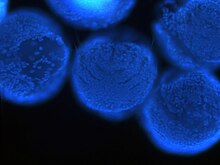Platynereis

| Platynereis | |
|---|---|
 | |
| Larvae of Platynereis dumerilii | |
| Scientific classification | |
| Domain: | Eukaryota |
| Kingdom: | Animalia |
| Phylum: | Annelida |
| Clade: | Pleistoannelida |
| Subclass: | Errantia |
| Order: | Phyllodocida |
| Family: | Nereididae |
| Subfamily: | Nereidinae |
| Genus: | Platynereis Kinberg, 1865 |
Platynereis is a genus of marine annelid worms that belongs to the Nereididae, a family of errant polychaete worms.[1][2]
The species Platynereis dumerilii is used in development biology to study development (embryogenesis), in particular because their embryos are largely transparent, and thus easy to follow.[3] Apical organs such as this one are photosensitive which is a key component in their formation. They also have a common ancestor with cnidarians and bilaterians.[4]
- Platynereis abnormis
- Platynereis antipoda
- Platynereis arafurensis
- Platynereis australis
- Platynereis bengalensis
- Platynereis bicanaliculata
- Platynereis calodonta
- Platynereis cebuensis
- Platynereis coccinea
- Platynereis cristatus
- Platynereis dumerilii
- Platynereis festiva
- Platynereis fuscorubida
- Platynereis hugonis
- Platynereis hutchingsae
- Platynereis insolita
- Platynereis karaka
- Platynereis kau
- Platynereis magalhaensis
- Platynereis mahanga
- Platynereis massiliensis
- Platynereis megalops
- Platynereis mucronata
- Platynereis nadiae
- Platynereis pallida
- Platynereis patagonica
- Platynereis polyscalma
- Platynereis pulchella
- Platynereis sinica
- Platynereis tongatabuensis
- Platynereis uniseris
References
[edit]- ^ Kinberg1865, J. G. H. (1865). "Annulata nova. [Continuatio.]". Öfversigt af Königlich Vetenskapsakademiens förhandlingar, Stockholm (in Latin). 22 (2): 167–179. Retrieved 6 August 2018.
{{cite journal}}: CS1 maint: numeric names: authors list (link) - ^ Read, G.; Fauchald, K. "World Polychaeta database. Platynereis Kinberg, 1865". World Register of Marine Species. Retrieved 6 August 2018.
- ^ Fischer, A. H.; Henrich, T.; Arendt, D. (2010). "The normal development of Platynereis dumerilii (Nereididae, Annelida)". Frontiers in Zoology. 7: 31. doi:10.1186/1742-9994-7-31. PMC 3027123. PMID 21192805.
- ^ Marlow, Heather; Tosches, Maria Antonietta; Tomer, Raju; Steinmetz, Patrick R.; Lauri, Antonella; Larsson, Tomas; Arendt, Detlev (24 January 2014). "Larval body patterning and apical organs are conserved in animal evolution". BMC Biology. 12: 7. doi:10.1186/1741-7007-12-7. PMC 3939940. PMID 24476105. S2CID 8733857.
- ^ Bisby F.A.; Roskov Y.R.; Orrell T.M.; Nicolson D.; Paglinawan L.E.; Bailly N.; Kirk P.M.; Bourgoin T.; Baillargeon G.; Ouvrard D. (red.) (2011). "Species 2000 & ITIS Catalogue of Life: 2011 Annual Checklist". Species 2000: Reading, UK. Retrieved 24 September 2012.